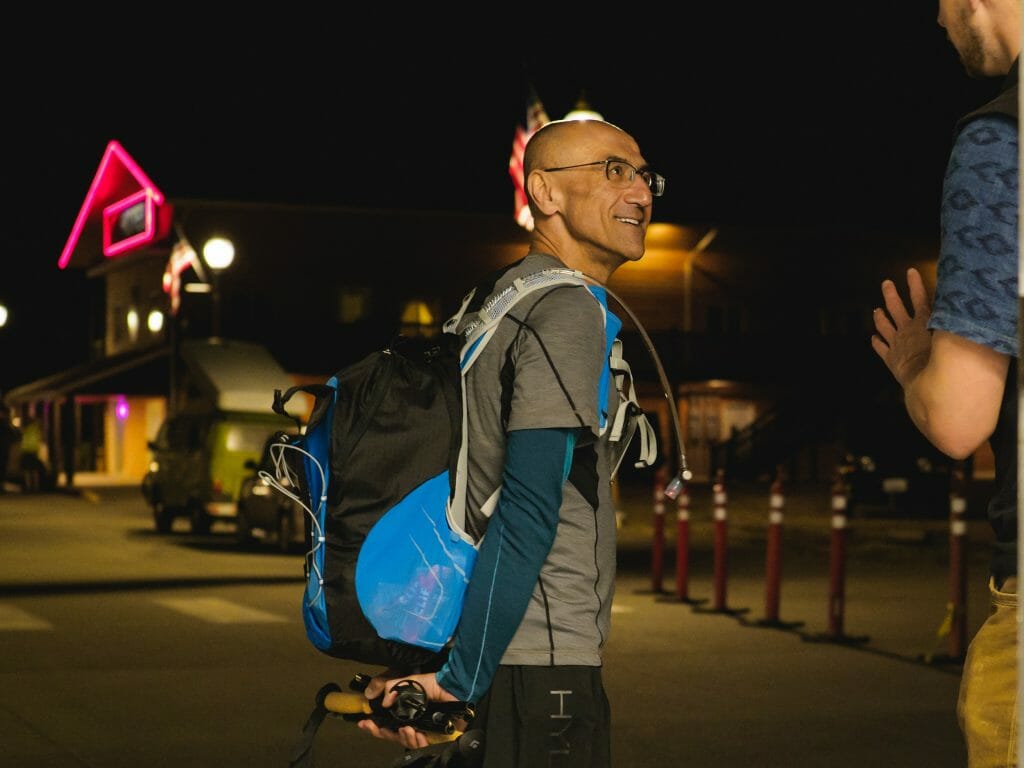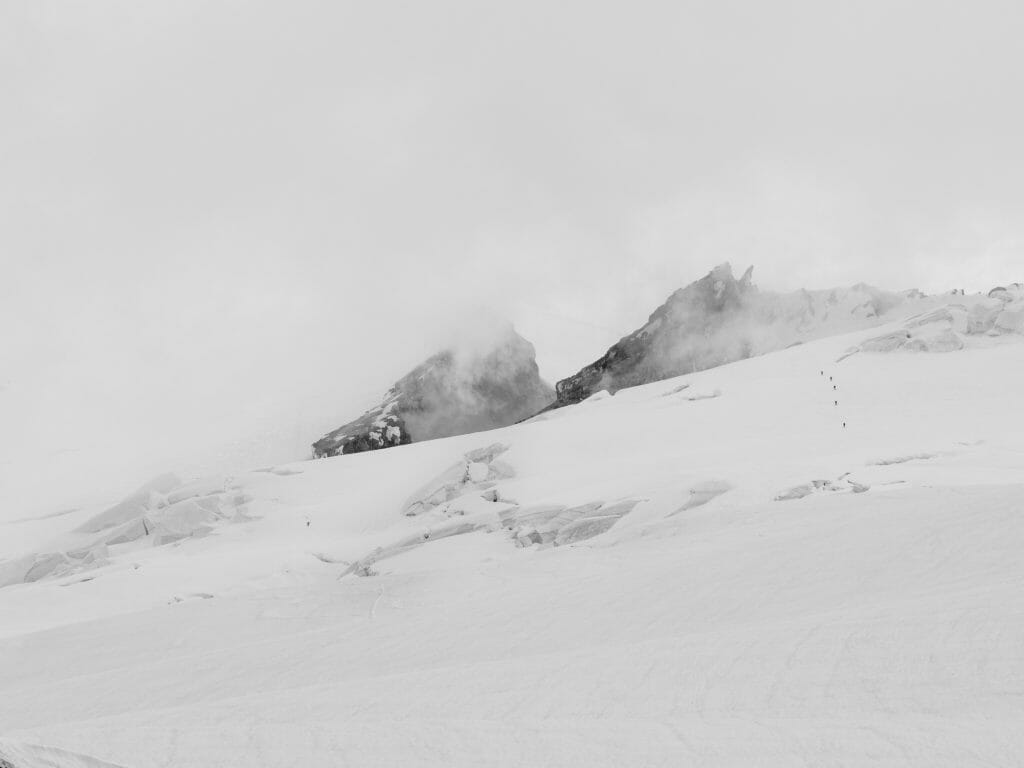I got my only view of Mount Baker on my drive to the race start in Concrete, Washington. I saw the alpenglow on the mountain. It was so clear. I wish the weather had stayed like that the whole race, but it didn’t work out that way.
The Mount Baker Marathon would be my first ultra—my first organized race of any sort, really. I’ve been climbing and mountaineering for 31 years, and I trail run when I can’t climb, just to get outside, but I don’t consider myself a runner. Even so, to improve my overall fitness for an upcoming six-month summer climbing trip, during which I plan to do a bunch of peaks in the Canadian Rockies and the States car-to-car in a day, I decided to sign up and train for a late-spring ultra on the West Coast.
The Mount Baker Marathon popped up in my search, and it appealed immediately: 55 miles and 10,000 feet of elevation gain, with a unique mountaineering twist. Instead of just running on roads and trails, we would go up the mountain, to the top of Sherman Peak.
I’ve been working with Uphill Athlete Master Coach Steve House for eight months now, following a series of Custom 8-Week Training Plans. First, he helped me come back from shoulder surgery, then he cycled me through an ice climbing block and a general climbing block. When it came time to focus on the race, Steve knew I wasn’t a runner, so he gave me a careful program that would push me, but not so hard I’d get injured; that was really critical to me. He helped me build up as best I could within the four months I had to train.
Going in, all I wanted to do was finish the race. I’m 56 and I knew I wouldn’t be racing against the top guys. I had my mind set on getting it done. That’s all, nothing else.

Farzin Fallah at check-in.
All of us racers met at the police station in Concrete at around 6 p.m. on June 2 for gear check. Then we moved to the local theater for a presentation on the race. The weather was really good that evening, but the forecast was for a storm to come in the next day. After the briefing, we got geared up for the race start at midnight.
This would be my second time on Mount Baker. Back in 2005, I attempted the Coleman Glacier Headwall route on the north side of the mountain, but it snowed and my team had to bail. Even with the coming storm, I hoped to make the summit of Sherman Peak this time.
Thirty-four of us set off into the night, all with our own goals. I started out running with a woman in her mid-60s who I think was a bit afraid of running in the dark. I slowed down slightly to match her pace and keep her company. We jogged out of town, and after about a mile or two we transitioned to logging roads, working our way toward Baker. It was amazing how fast some of the racers went out. I wouldn’t see them again until their return trip down the mountain.
There were six aid stations. The first three were accessible by road, with the third one at tree line, right before the trailhead on the mountain. That’s where the race organizers had shuttled our mountain gear—ice axes, crampons, and a change of clothing—and that’s also where they fed us a really awesome breakfast of pancakes, bacon, and coffee. After eating my fill, I changed into my mountain clothing and started up the snow.
Initially the snow was a bit patchy, but after about a mile it was all snow—very soft snow. I started out in snowshoes, but they were so clunky and big that they slowed me down more than anything. I took them off after a half hour and did a lot of post-holing. It would have been much easier if it had been just a bit colder. The route was flagged with neon tape, and once we got above tree line, there were markers in the snow every 50 or 60 yards so you could clearly see where to go. The terrain got a lot steeper then, so I was mostly walking uphill fast. I couldn’t run it by any means.
Aid station four came right before the fixed ropes and the glacier. I strapped my crampons onto my trail runners, got some water, and went up about half a mile to where I hit the fixed lines. I clipped in and started climbing up. If I could have done one thing differently, I would have changed into a lightweight mountain boot instead of staying in my trail runners, because a lot of energy went to waste due to the flexibility of the shoes.
By the time I was on the fixed lines, at around 10 a.m., the storm had come in, bringing rain and snow flurries. I had already seen people returning from the top. Some of these guys were super fast. The fastest guy finished it in just over 12 hours, which was unbelievable. But there was no sense of competition. They cheered me on, and I cheered them on. We were like a small community, everybody very encouraging and down-to-earth. It was all good vibes.
As I got higher up the mountain, visibility worsened. Without the fixed lines, there’s no way anybody would have gone for the top. These were full-on conditions, definitely the most challenging aspect of the day—and the complete opposite of the heat I’d been training in back home in San Diego. I was grateful that I could get to the top because of the fixed ropes and the efforts of both the race organizers and the group of local snowmobilers who’d ferried all the ropes and gear and people up the mountain.

Racers approaching Sherman Peak (10,160 feet/3,097 meters) a subpeak of Mount Baker (10,781 feet/3,286 meters) in stormy conditions
I followed the fixed lines and reached the highest aid station around noon. That was where the last of the fixed rope was. There had been a piece of rope you could clip in to and go all the way to the edge of Sherman Peak, but they had removed it by then because of the storm. With the aid station crew cheering me on, I started back down the fixed lines, moving as fast as I could to meet the 18-hour time limit.
It was raining steadily when I got back to the third aid station at the trailhead, and I was completely soaked to the bone. Two men and two women bailed at that point, but two other men, a woman, and I all decided to continue. I started my push toward town around four. I had to walk all the uphills, but I had plenty of energy in the tank. The air temps weren’t cold. As long as I kept moving, I stayed warm.
At no point that day did I feel like I was in over my head or that it was too tough. I followed Steve’s guidelines for my heart rate zones and how far I could push during the race. If I hadn’t done the training and hadn’t paced myself properly, there’s no way I could have taken on 55 miles with 10,000 feet of elevation gain, a lot of it in soft snow. I had a blast out there.
I crossed the finish line at 9:03 p.m., the 28th finisher of 28. The race director had generously extended the time limit to 21 hours, so I got an unofficial finish, along with the three other racers who’d left the third aid station around the same time as me. I didn’t care that I was wet or that I was the last person to get back. I felt really good and really positive: I had finished the race, and I’d finished it with reserves.
-by Uphill Athlete Farzin Fallah

